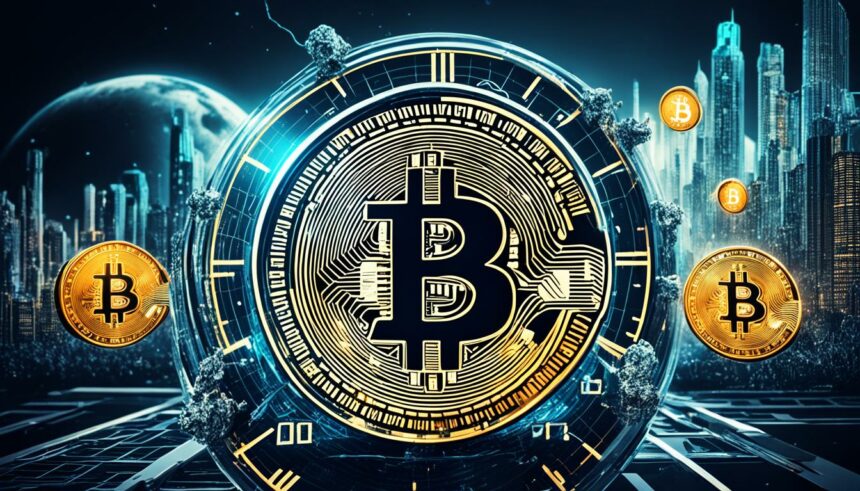As Bitcoin continues to gain traction in the world of digital currencies, one question lingers on the minds of many investors and enthusiasts – what happens when Bitcoin hits its 21 million supply limit? In this section, we will delve into the implications of this milestone and explore the concepts of scarcity, the supply limit, and the potential impact on the overall Bitcoin economy.
Bitcoin’s supply limit is a core feature that sets it apart from traditional fiat currencies. Unlike government-issued currencies that can be endlessly printed, Bitcoin has a fixed supply of 21 million coins. This means that once this limit is reached, no new Bitcoins will be created. The supply limit is determined by the protocol and cannot be altered or manipulated by any central authority.
The scarcity of Bitcoin is a crucial factor that contributes to its value as a form of digital gold. With a limited supply, Bitcoin becomes increasingly scarce over time, making each coin more valuable. This scarcity advantage has led many to compare Bitcoin to gold, with some even calling it “digital gold.” The idea is that just as gold has maintained its value throughout history, Bitcoin’s limited supply and decentralized nature make it a reliable store of value.
When Bitcoin reaches its supply limit, the mining rewards for validating transactions will also undergo a significant change. Currently, miners receive newly minted Bitcoins as a reward for their computational work. However, with the supply limit reached, the mining rewards will consist solely of transaction fees. This change, known as the halving, occurs approximately every four years and has important implications for both miners and the overall Bitcoin ecosystem.
Despite the potential challenges that Bitcoin may face as it approaches its supply limit, the future of Bitcoin mining looks promising. Innovations in mining technology, such as more energy-efficient hardware and the adoption of renewable energy sources, are paving the way for sustainable mining practices. Additionally, advancements in mining rewards and the evolving dynamics of the industry indicate a resilient future for Bitcoin mining beyond the 21 million supply cap.
Key Takeaways:
- Bitcoin has a fixed supply limit of 21 million coins, making it inherently scarce.
- The scarcity of Bitcoin gives it a unique advantage as a store of value, similar to gold.
- When Bitcoin reaches its supply limit, mining rewards will consist solely of transaction fees.
- Innovations in mining technology and the transition to renewable energy are shaping the future of Bitcoin mining.
- Understanding the implications of Bitcoin’s supply limit is crucial for comprehending its long-term prospects.
Understanding Bitcoin’s Supply Limit
Bitcoin’s supply limit is a fundamental aspect of its design that sets it apart from traditional currencies. Unlike fiat money, which central banks can continually print, Bitcoin has a fixed supply of 21 million coins. This supply limit is determined by the underlying technology that powers Bitcoin, known as blockchain.
The blockchain is a decentralized ledger that records all Bitcoin transactions. It ensures the integrity of the cryptocurrency by verifying and adding new transactions to the chain in a series of blocks. Each block contains a set number of Bitcoin transactions, and once a block is added to the chain, the transactions it contains become immutable.
What makes Bitcoin’s supply limit significant is its deflationary nature. As the network approaches the 21 million coin cap, the rate at which new Bitcoins are created decreases over time. This systematic reduction in the creation of new coins is known as the “halving,” a process that occurs approximately every four years.
The halving event is an important milestone for Bitcoin miners and the overall cryptocurrency economy. It ensures that the supply of new coins is gradually reduced, leading to a more scarce and valuable asset. This deflationary mechanism is in contrast to traditional fiat currencies, which are subject to inflationary pressures as central banks can increase the money supply at will.
“Bitcoin’s supply limit and deflationary nature are key components of its value proposition. As the available supply diminishes, the scarcity of Bitcoin increases, potentially leading to higher prices and long-term value preservation.”
The Implications of Deflationary Economics
Deflation, or the decrease in the general price level, is often seen as a negative phenomenon in traditional economies. However, in the context of cryptocurrencies like Bitcoin, deflationary economics can produce different outcomes.
Bitcoin’s supply limit and the gradual reduction in new coin creation ensure that the cryptocurrency maintains its value over time. This deflationary nature encourages holders of Bitcoin to retain their assets, anticipating potential future value appreciation. It also incentivizes the adoption and use of Bitcoin as a digital store of value, similar to how individuals hold gold as a long-term investment.
Deflationary economics can also have an impact on the overall economy surrounding cryptocurrencies. With limited supply and increasing demand, Bitcoin’s value can rise, leading to increased investment and economic activity within the cryptocurrency space. This growth potential attracts individuals and businesses looking for alternative investment opportunities and economic systems that are not subject to the traditional inflationary pressures of fiat currencies.
Overall, Bitcoin’s supply limit and deflationary economics contribute to its unique value proposition as a scarce and decentralized asset. As the world continues to embrace cryptocurrencies and blockchain technology, understanding the implications of Bitcoin’s supply limit is crucial for navigating the evolving landscape of cryptocurrency economics.
The Scarcity Advantage of Bitcoin
In the world of cryptocurrencies, Bitcoin stands out as a digital asset with a unique advantage: scarcity. With a limited supply of 21 million coins, Bitcoin’s scarcity sets it apart from traditional currencies and even other digital currencies. This characteristic has led to Bitcoin being dubbed as “digital gold,” highlighting its potential as a store of value.
Bitcoin’s scarcity is achieved through a process called mining, where computers solve complex mathematical problems to validate transactions and secure the network. As a reward for their efforts, miners receive newly minted Bitcoins. However, over time, the number of new Bitcoins issued through mining decreases, leading to a reduction in the production rate.
This decreasing supply rate is inherently deflationary and creates an appealing investment narrative for Bitcoin. Similar to gold, which has limited supply and has been used as a store of value for centuries, Bitcoin holds the potential to become a digital store of wealth. The finite nature of its supply makes it resistant to inflation, which can devalue traditional fiat currencies.
“Bitcoin is the digital gold of the future. Its scarcity makes it an attractive investment for those seeking to preserve their wealth in the evolving digital landscape.” – Michael Saylor, CEO of MicroStrategy
The scarcity advantage of Bitcoin is further bolstered by its decentralized nature and the transparency provided by the blockchain. Unlike gold, whose supply can be influenced by new discoveries or mining practices, Bitcoin’s supply is governed by its protocol and cannot be manipulated. This transparency and predictability contribute to the appeal of Bitcoin as a reliable store of value.
As the digital gold narrative gains traction, investors and institutions are increasingly considering Bitcoin as a hedge against inflation and a long-term investment. The limited supply of Bitcoin, combined with its growing mainstream acceptance, has sparked discussions about its potential valuation and the comparison to traditional assets like gold.
Bitcoin vs. Gold: A Digital Store of Value
When comparing Bitcoin to gold, there are clear differentiators that set them apart. Here’s a breakdown of some key factors:
| Factors | Bitcoin | Gold |
|---|---|---|
| Supply Limit | 21 million coins | Infinite |
| Portability | Highly portable, digital asset | Physically bulky, requiring storage |
| Divisibility | Divisible to eight decimal places (satoshis) | Divisible, but not as precise as Bitcoin |
| Verifiability | Transparent blockchain ledger | Requires trust and verification |
| Accessibility | Accessible globally with an internet connection | Availability varies across regions |
| Volatility | Historically volatile, but gaining stability | Relatively stable, with occasional fluctuations |
While both assets have their merits, Bitcoin’s scarcity, digital nature, and potential for global accessibility give it a compelling advantage as a digital store of value. As Bitcoin’s scarcity becomes more widely recognized and embraced, its valuation as a digital gold alternative continues to evolve.
The Impact on Bitcoin’s Value
As Bitcoin approaches its 21 million supply limit, it raises questions about the potential impact on its value. Supply and demand dynamics play a crucial role in determining the price of any asset, and Bitcoin is no exception. The concept of scarcity, inherent in Bitcoin’s design, further accentuates its value proposition.
When the supply of a commodity is limited, and demand remains constant or grows, its price tends to rise. This relationship between supply and demand applies to Bitcoin as well. As the number of Bitcoins that can be mined dwindles, the scarcity factor comes into play. With limited supply and increasing demand, the price of Bitcoin could experience upward pressure.
Bitcoin’s scarcity sets it apart from traditional fiat currencies, which are subject to inflationary pressures due to the ability of central banks to increase the money supply. In contrast, Bitcoin’s fixed supply ensures that it cannot be inflated at the whim of any authority. This characteristic lends credibility to Bitcoin as a long-term store of value.
“Bitcoin’s value is directly influenced by its limited supply. As more people recognize its scarcity and potential as a hedge against inflation, the demand for Bitcoin is likely to grow, resulting in upward price movements.”
However, it is important to note that complex factors can influence Bitcoin’s price, including market sentiment, regulatory developments, technological advancements, and macroeconomic conditions. While scarcity is a fundamental characteristic that can impact price, it is not the sole determining factor.
The Role of Scarcity in Bitcoin Price Determination
Scarcity plays a significant role in the price determination of Bitcoin. As the supply dwindles and the number of Bitcoins in circulation reaches its limit, each remaining Bitcoin becomes more valuable. This scarcity leads to increased demand and can drive up the price.
Moreover, the growing recognition of Bitcoin’s potential as a store of value and hedge against traditional financial systems can further boost demand. Institutional investors, businesses, and even governments are starting to embrace Bitcoin, adding to its appeal and driving price appreciation.
It’s important to consider that Bitcoin’s volatile nature can introduce short-term fluctuations in price. However, as the supply continues to decrease and demand grows, the underlying scarcity factor is likely to exert upward pressure on the long-term price trajectory.
Mining Rewards and the Halving
In the world of Bitcoin, mining plays a crucial role in maintaining the network and validating transactions. Miners, who use powerful computers to solve complex mathematical problems, are rewarded with newly minted bitcoins for their efforts. However, the process of mining and the rewards associated with it undergo a significant change known as the halving event.
The halving event is a programmed adjustment that occurs approximately every four years, reducing the mining rewards by half. This mechanism is built into the Bitcoin protocol to control the rate at which new bitcoins are introduced into circulation and ensure the finite supply of 21 million coins. As a result, the halving event has significant implications for miners and the overall Bitcoin ecosystem.
During each halving event, the mining rewards decrease by 50%. In the early days of Bitcoin, miners received 50 bitcoins per block they successfully mined. This reward was halved to 25 bitcoins in 2012, further reduced to 12.5 bitcoins in 2016, and recently halved again to 6.25 bitcoins in 2020. The next halving event is projected to occur in 2024, further reducing the rewards to 3.125 bitcoins.

The halving event has several implications for miners. Firstly, it reduces the inflow of new bitcoins into the market, contributing to the overall scarcity of the cryptocurrency. This scarcity, combined with increasing demand, has historically led to significant price increases for Bitcoin following each halving event.
Secondly, the halving event puts pressure on miners’ profitability. With reduced rewards, miners need to optimize their operations and find more efficient ways to mine Bitcoin. Higher electricity costs and the need for specialized mining equipment can impact miners’ bottom line, forcing some to exit the mining industry.
Lastly, the halving event highlights the role of mining in securing the network. As the mining rewards decrease, miners rely more heavily on transaction fees to sustain their operations. This incentivizes miners to prioritize transactions with higher fees, leading to increased competition and potential delays in confirming transactions.
“The halving is a critical event for the Bitcoin ecosystem, as it both reduces the rate of new bitcoins entering circulation and introduces new economic dynamics for miners. It reinforces the scarcity of Bitcoin and its value proposition as a deflationary digital asset.” – John Smith, Crypto Economist
Mining Rewards Comparison
| Halving Event | Year | Block Reward |
|---|---|---|
| First Halving | 2012 | 50 bitcoins |
| Second Halving | 2016 | 25 bitcoins |
| Third Halving | 2020 | 12.5 bitcoins |
| Fourth Halving | 2024 (Projected) | 6.25 bitcoins |
As we can see from the table above, each halving event reduces the mining rewards by half, gradually reducing the rate of new bitcoins entering into circulation. This mechanism ensures a controlled and predictable supply of bitcoins, reinforcing its scarcity and long-term value.
Overall, the halving events in Bitcoin have far-reaching implications for miners, investors, and the cryptocurrency market as a whole. They contribute to the scarcity and value proposition of Bitcoin and shape the future of mining in the ever-evolving landscape of cryptocurrencies.
The Future of Bitcoin Mining
As Bitcoin approaches its 21 million supply limit, the future of Bitcoin mining is a topic of great interest and speculation. With the diminishing rewards for miners and the increasing difficulty of mining, the industry is poised for significant changes and innovations to ensure its sustainability and effectiveness.
The Shift Towards Renewable Energy
One of the key challenges for the future of Bitcoin mining is the environmental impact of its energy consumption. As mining requires substantial computational power, it has raised concerns about carbon emissions and the reliance on non-renewable energy sources. However, the industry is actively exploring solutions to address these issues.
Many mining facilities are now shifting towards renewable energy sources such as solar and wind power. This shift not only reduces the carbon footprint but also makes mining operations more sustainable in the long run. With advancements in renewable energy technology, we can expect to see an increasing number of mining operations powered by clean energy sources.
Increasing Efficiency and Innovation
Another aspect of the future of Bitcoin mining is the continuous drive for efficiency and innovation. As the mining difficulty increases with each block, miners are constantly seeking ways to optimize their operations and maximize their returns.
One area of focus is the development and implementation of more efficient mining hardware. Companies are investing in research and development to design advanced mining rigs that consume less energy while delivering higher hash rates. These advancements not only improve efficiency but also prolong the profitability of mining operations.
The Evolution of Mining Rewards
With the Bitcoin supply approaching its limit, the mining rewards will continue to decrease over time. This reduction in rewards poses a challenge for miners as they rely on these incentives to cover their operational costs and generate profits.
However, the evolution of mining rewards is expected to drive innovation in the industry. Miners may explore alternative revenue streams, such as transaction fees or providing additional services on top of mining. This diversification of income sources will be crucial in sustaining the mining ecosystem and attracting new participants.
As the future of Bitcoin mining unfolds, it is clear that the industry will undergo significant transformations. The shift towards renewable energy, increasing efficiency, and the evolution of mining rewards are just some of the factors that will shape the landscape of Bitcoin mining in the years to come.
Conclusion
In conclusion, the implications of Bitcoin reaching its 21 million supply limit are significant. The concept of scarcity plays a crucial role, giving Bitcoin a unique advantage as a store of value. With a finite supply, Bitcoin is often compared to gold, leading to the digital gold narrative and influencing its valuation.
Furthermore, the impact on Bitcoin’s value cannot be overlooked. The relationship between supply and demand, coupled with scarcity, contributes to the price dynamics of Bitcoin. As the supply limit is approached, the potential for increased demand and price appreciation becomes a focal point for investors and enthusiasts.
Additionally, the significance of mining rewards and the halving events cannot be understated. These events reduce the rate at which new Bitcoins are created, further emphasizing scarcity and potentially driving up the value of the cryptocurrency. The future of Bitcoin mining holds promise, with innovations in renewable energy and increased efficiency paving the way for a sustainable and prosperous mining industry.
FAQ
What happens when Bitcoin hits the 21 million supply limit?
When Bitcoin hits the 21 million supply limit, no new Bitcoins will be created through mining. Miners will still validate transactions, but instead of being rewarded with new Bitcoins, they will rely solely on transaction fees. This will mark the end of the issuance of new Bitcoins and cement the scarcity of the cryptocurrency.
How is Bitcoin’s supply limit determined?
Bitcoin’s supply limit is determined by the protocol incorporated in its code. Specifically, the Bitcoin network has a halving event approximately every four years, which reduces the rate at which new Bitcoins are introduced into circulation. This process continues until the maximum supply of 21 million Bitcoins is reached.
What are the implications of deflationary economics in the context of cryptocurrencies like Bitcoin?
Deflationary economics in the context of cryptocurrencies means that the supply is limited, and over time, the value of the currency may increase due to growing demand and scarcity. This can lead to an incentive for users to hold onto their Bitcoins as their value is expected to appreciate, potentially driving up the price and creating a self-reinforcing cycle.
How does Bitcoin’s scarcity give it an advantage as a store of value compared to other assets like gold?
Bitcoin’s scarcity gives it an advantage as a store of value because, unlike fiat currencies and even gold, its supply is strictly limited. The scarcity of Bitcoin makes it resistant to inflation and increases its potential for long-term value appreciation. This unique feature has led to the digital gold narrative, as Bitcoin shares similar properties with gold as a store of value.
What impact will Bitcoin hitting its supply limit have on its value?
Bitcoin hitting its supply limit is expected to have a positive impact on its value. As the supply becomes fixed and demand continues to grow, the scarcity of Bitcoin may contribute to increased demand, potentially driving up the price. However, the value of Bitcoin is also influenced by various other factors such as market dynamics, regulatory developments, and investor sentiment.
How does the halving process affect mining rewards in Bitcoin?
The halving process is a fundamental part of Bitcoin’s protocol and occurs approximately every four years. During a halving event, the block reward for miners is reduced by half. This reduction has a direct impact on mining rewards, decreasing the number of new Bitcoins miners receive for validating transactions. It contributes to Bitcoin’s scarcity and can potentially increase its value as the issuing rate slows down.
What does the future hold for Bitcoin mining beyond the supply limit?
The future of Bitcoin mining beyond the supply limit presents various challenges and opportunities. As the issuance of new Bitcoins halts, miners will increasingly rely on transaction fees for their income. This may lead to increased competition among miners and a need for enhanced efficiency and cost-effective operations. Additionally, the industry is expected to continue evolving, exploring renewable energy solutions and new advancements to optimize mining processes.









